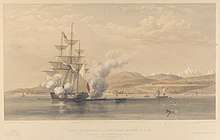HMS Highflyer (1851)
HMS Highflyer was a 21-gun wooden screw frigate (later re-designated a corvette) of the Royal Navy. She was built on the River Thames by C J Mare and launched on 13 August 1851. She spent twenty years in service, including action in the Crimean War and the Second Opium War, before being broken up at Portsmouth in May 1871.
.jpg) Profile of Highflyer dated 1863 | |
| History | |
|---|---|
| Name: | HMS Highflyer |
| Ordered: | 25 April 1847 |
| Builder: | C J Mare & Co., Leamouth Wharf |
| Cost: | £56,075 |
| Laid down: | January 1850 |
| Launched: | 13 August 1851 |
| Commissioned: | 10 April 1852 |
| Fate: | Broken up May 1871, at Portsmouth |
| General characteristics [1] | |
| Class and type: | Highflyer-class corvette |
| Displacement: | 1,737 1⁄2 tonnes |
| Tons burthen: | 1,153 bm |
| Length: | |
| Beam: | 36 ft 4 in (11.07 m) |
| Draught: | 15 ft 9 in (4.80 m) |
| Depth of hold: | 22 ft 8 in (6.91 m) |
| Installed power: | 702 ihp (523 kW) |
| Propulsion: |
|
| Sail plan: | Full-rigged ship |
| Speed: | 9.4 kn (17.4 km/h) under steam |
| Armament: |
|
Design
Highflyer was ordered as a small wooden frigate to a design by the Surveyor's Department of the Admiralty on 25 April 1847; she and her sister Esk were re-designated as corvettes in 1854. In common with other screw corvettes of the time, she was envisaged as a steam auxiliary, intended to cruise under sail with the steam engine available for assistance. Commensurately she was provided with a full square sailing rig. Her geared two-cylinder horizontal single-expansion steam engine, provided by Maudslay, Sons & Field, developed 702 indicated horsepower (523 kW) and drove a single screw.[1]
Construction
The design was approved in November 1849, and she was laid down in January 1850 in the Leamouth Wharf yard of C J Mare & Co. on the River Thames. She was launched on 18 August 1851 and commissioned at Woolwich on 15 March 1852 under Captain Henry James Matson.[2] The cost of building came to £27,105 for the hull, £17,431 for the machinery and £11,539 for fitting out.[1]
Service history

After commissioning, Highflyer completed fitting out on 10 April 1852. Initially she served on the North America and West Indies Station; her first commander, Captain Matson, died on 14 December 1852, and she was then placed under the command of Captain Edmund Heathcote. On 1 April 1853 command passed to Captain John Moore, under whom she sailed to join the Mediterranean Fleet after taking part in the 1853 Naval Review as part of the starboard division,.[3] She was deployed in 1854 to the Black Sea during the Crimean War.[2]
After recommissioning at Portsmouth under Captain Charles Shadwell on 1 August 1856, she sailed for the China Station, where she took part in the Second Opium War. She was present at the capture of Canton in December 1857 and the Second Battle of Taku Forts on 25 June 1859.[2] Midshipman John Fisher, later Baron Fisher of Kilverstone, served in her during the mid-1850s. Captain William Andrew James Heath took over command from Captain Shadwell on 2 January 1860, still in the Far East.
Highflyer paid off at Portsmouth on 31 May 1861, but recommissioned again on 15 December 1864 under Captain Thomas Malcolm Sabine Pasley, for the Cape of Good Hope and East Indies Stations. There are references to service in the Persian Gulf - in January 1866, Highflyer bombarded a disputed fort at Al Zorah, in Ajman.[4]
She paid off for the last time on 31 August 1868 and was broken up at Portsmouth in May 1871.[2]
References
- Winfield (2004), p.207
- "HMS Highflyer at William Loney RN website". Retrieved 23 May 2010.
- "The 1853 Naval Review at William Loney RN website". Retrieved 23 May 2010.
- Lorimer, John (1915). Gazetteer of the Persian Gulf. British Government, Bombay. p. 727.
- Colledge, J. J.; Warlow, Ben (2006) [1969]. Ships of the Royal Navy: The Complete Record of all Fighting Ships of the Royal Navy (Rev. ed.). London: Chatham Publishing. ISBN 978-1-86176-281-8.
- Winfield, R.; Lyon, D. (2004). The Sail and Steam Navy List: All the Ships of the Royal Navy 1815–1889. London: Chatham Publishing. ISBN 978-1-86176-032-6.